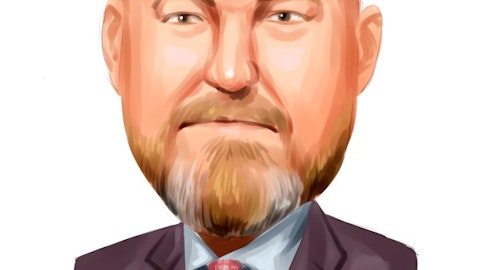Jack Wallace: Hey, thanks for taking my questions, and I appreciate the multi-year guidance outlook. Echoing comments from the prior analyst, it does sound like a new transition year and then a pretty exciting ’25. Focusing on ’25, just wanted to get a better understanding for how the MHS deal impacts the model. And maybe more specifically with the terms of that contract, if I understand correctly, the task order ends sometime in the middle of ’25. And just thinking about contribution from MHS in the back half of that year, what is in the guidance for ’25? And how should we be thinking about that customer once the task order ends?
Ido Schoenberg: Maybe I’ll take the headline and then Bob will give you more of the details. This year is really not a transition year of any sort. We are basically investing in a new market segment, which is the government market segment, take this out and you can see the transition in our number already today. But we are doing some really big investment with the Military Health Service that will allow us to get very strong returns, which are already contracted with this client and hopefully with other similar clients in the same sector for our work with Leidos and others. We talked in the last call about the task order, the $180 million task order. It is already budgeted and contracted, and it includes a few phases. The initial phase, which we are now going through, and already part of it is live, as I mentioned earlier, is the deployment in five sites of the entire portfolio that will step up for the full enterprise deployment.
This is about one go-live per quarter across the Behavioral Health, the Automated Chronic Care programs, and of course the Converge deployment. From that, we’re going to step up, in ’25, to the full enterprise. This vehicle that we are using, the financial vehicle is covering us, but it does cover the entire Military Health Service GENESIS contract of the government that includes the EHR and other elements. So, this is really the core infrastructure for the Military Health Systems. We are quite confident that this will continue through the process going forward. And we believe that assuming that we execute on what we need to do, our likelihood of continuing to provide it is very, very high, because of the enormous investments that us and the rest of the partners are making in this deployment.
But we don’t believe there is a budgetary risk for this. This is a mission critical infrastructure, and we don’t see a scenario where the government will not do that. We think that in that setting, us not continuing, as I mentioned earlier, is very slim. Bob, I don’t know if you have anything to add.
Bob Shepardson: I think you covered it, Ido. Just to be clear, Jack, we’re assuming that run rate from the end of ’24, beginning of ’25, continues going forward. We’re not assuming any growth in it, although I think that’s conservative. But we are assuming that it’s part of a sustaining contract together with the multi-billion dollar EHR deployment that the government undertook for the DHA here over the course of the last couple of years.
Jack Wallace: Excellent. That’s really helpful. And then, Ido, you alluded to it before, but as we’re thinking about potential expansion within the broader government customer, I think with the VA and others, what I think I heard you say was pretty much all of the heavy lifting on the R&D side getting done this year. So, when future expansions potentially happen, it’s a matter of just turning on the software and some training at that point. There’s not the big lift. Do I have that correct? And if so, just as a quick follow-up to that, how have your discussions gone with the Military Health System and others about potential expansion opportunities? Thank you.
Ido Schoenberg: So, yes, the short answer is, you are correct. Look, we’re doing a lot of work today that is super relevant to the Military Health System, but will pay off to the entire sector. So, just a real quick headline, we are now creating multiple environments, a demonstration environment, staging environment, production, pre-production, across our entire portfolio, SilverCloud, Automated Care, and Converge. We are configuring all those systems. We are going through the elaborate and detailed cybersecurity hardening and accreditation of the MHS and the government. We are training a lot of users and administrators, and of course, we are going live in the sequence that I described and beginning to measure impact, which we are confident will be very encouraging going forward.
Upscaling from there, which is contracted and budgeted fully, does not require any additional effort. It’s an identical environment. And as I mentioned earlier, when we turn to the next government client, we are probably not going to repeat a lot of this work. There is a lot of similarity between this client and other clients in the segment.
Bob Shepardson: Jack, I’ll just add that…
Jack Wallace: Thank you so much.
Bob Shepardson: The great thing about the project we have now is we’re integrating into a brand new singular EHR across the DHA that was just implemented to the degree that, like in many health systems, you might have a customer in the government sector that has multiple EHRs and different environments that have built up over time, it wouldn’t be as clean, but this one really is. And this is a great one to get going on. And all of the work that we’re doing here relates to operation in that ecosystem regardless of what the EHR is.
Jack Wallace: Got it…
Ido Schoenberg: Maybe just to end with one last point which is an important takeaway. One, with the bookings that we shared today, we really have a very, very high degree of visibility into everything, into our full profitability in the ’26. And something that is even more important, we believe that the mechanics and DNA of this transaction is going to be very typical to future transactions you’re going to see in Amwell. Mainly, we are mostly selling, almost entirely selling software, which is very scalable and much higher margin than before. And if you can connect the dots and extrapolate from there, this really opens the new page and new era for Amwell, as we are really moving into software SaaS, almost entirely a world which is very different from where we were only a couple of years ago.


